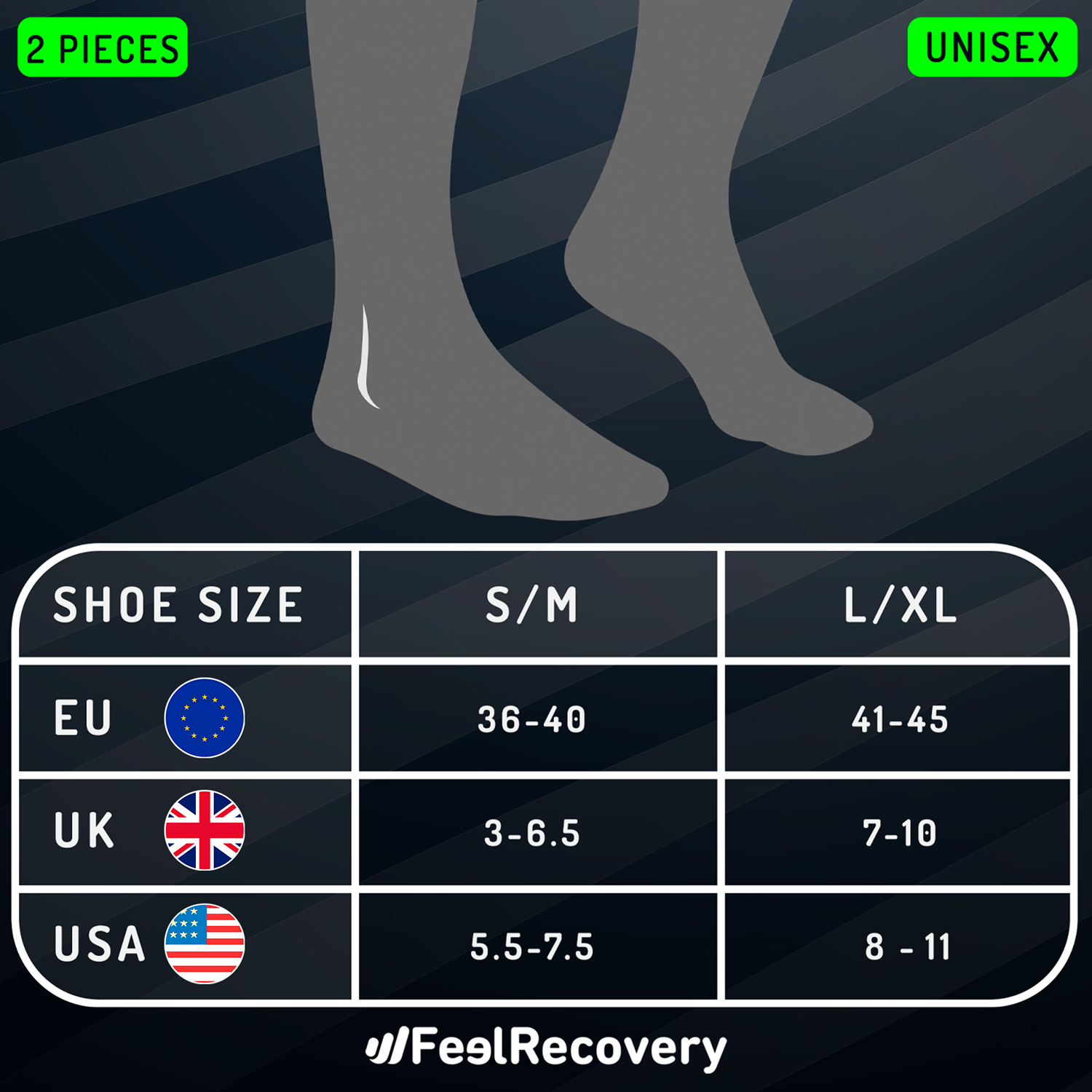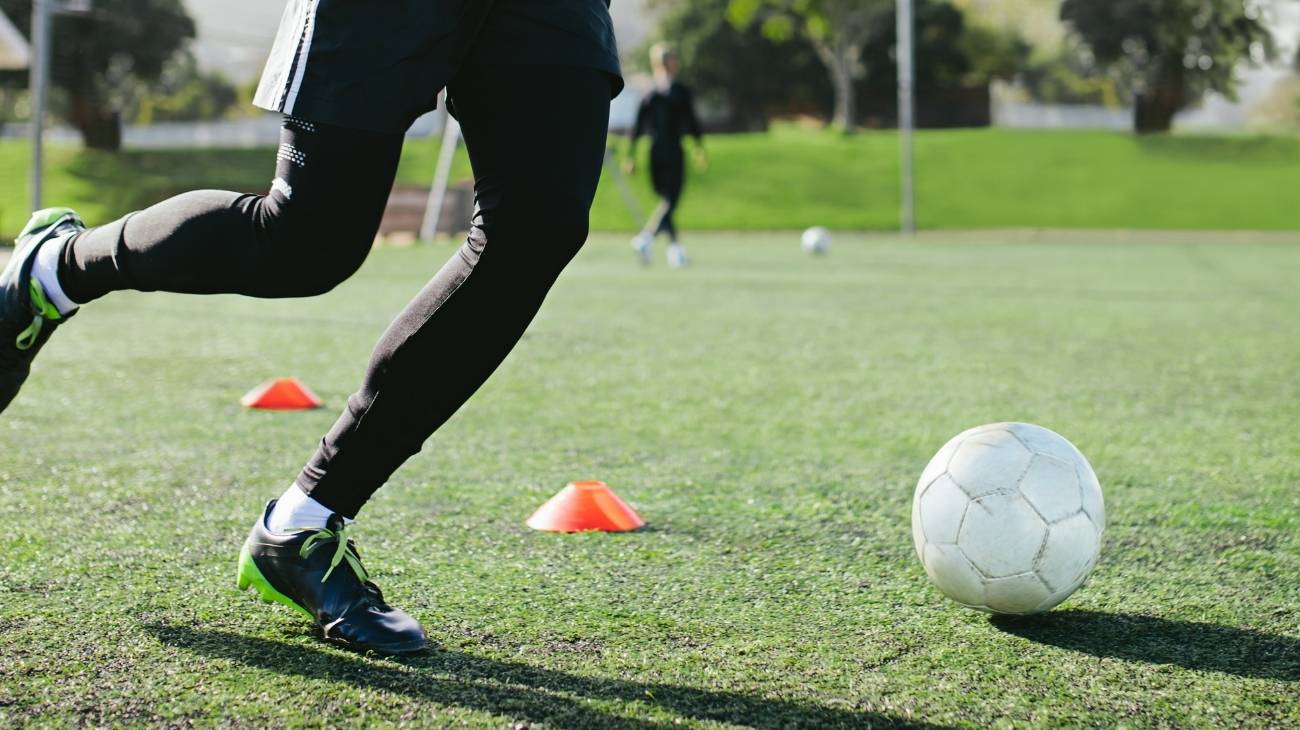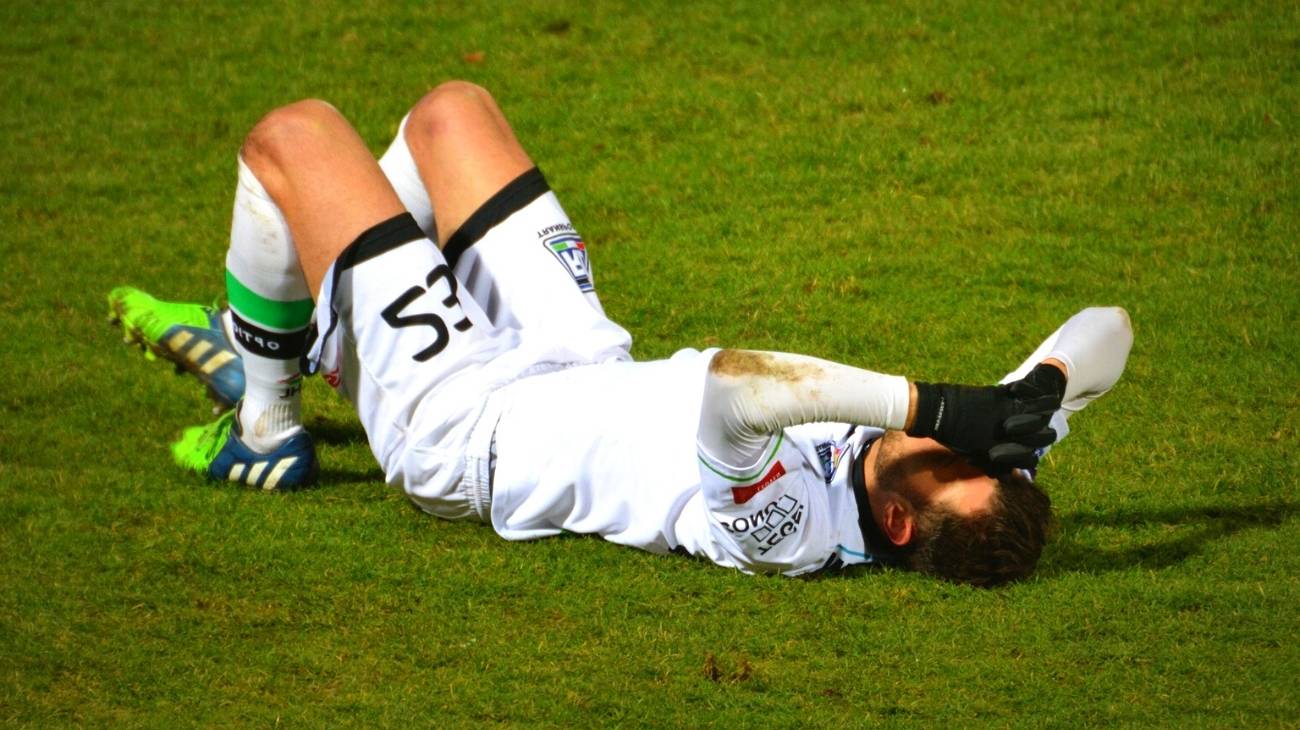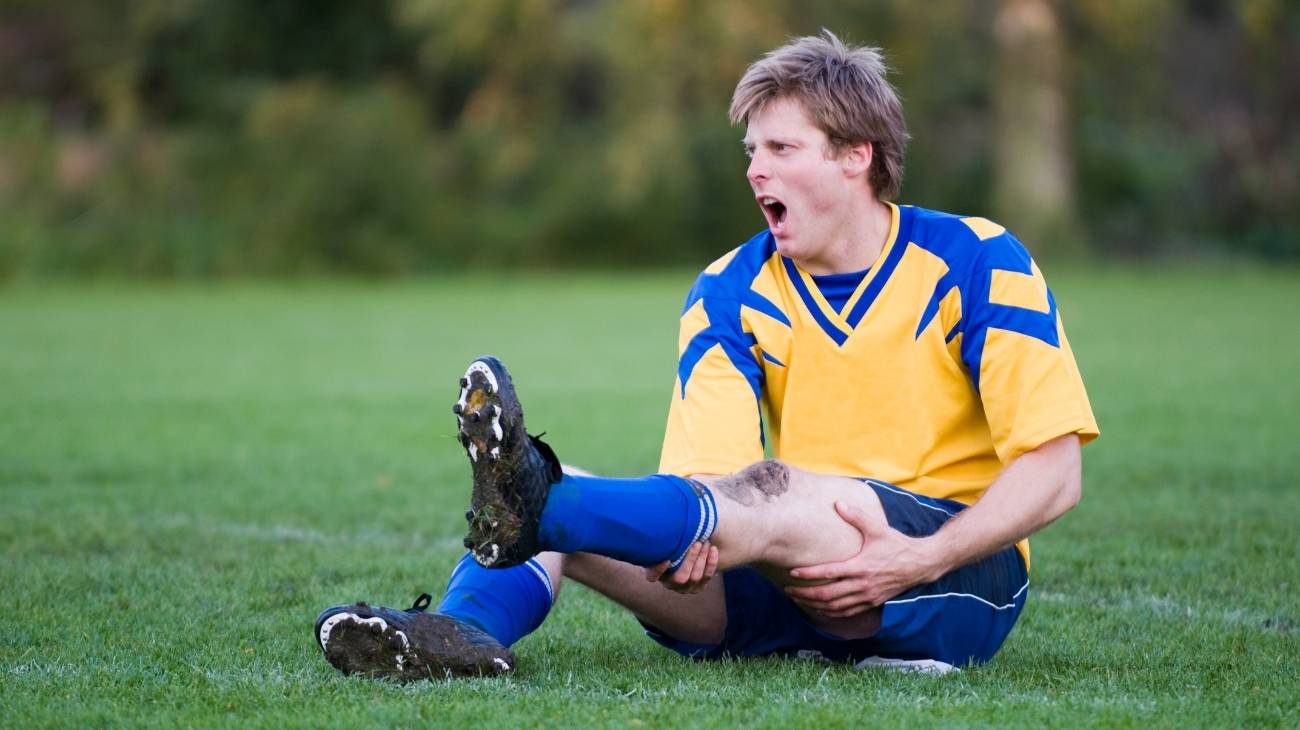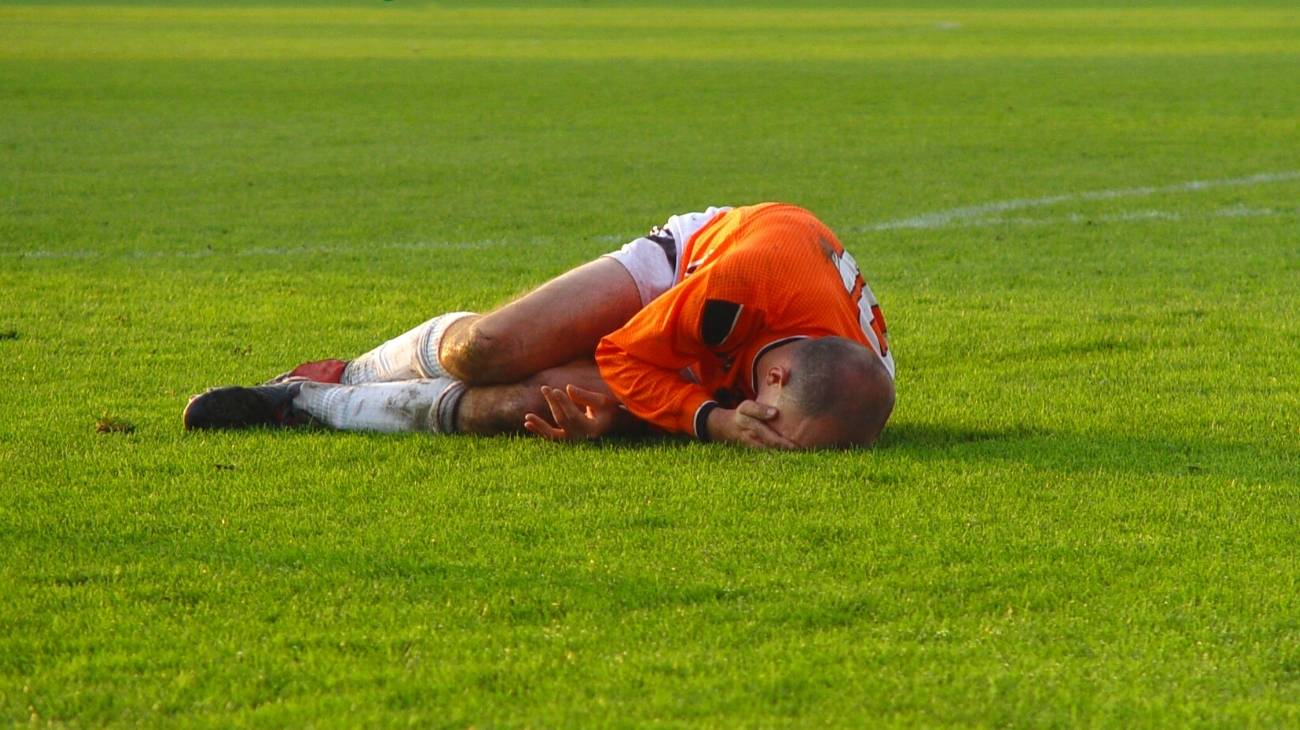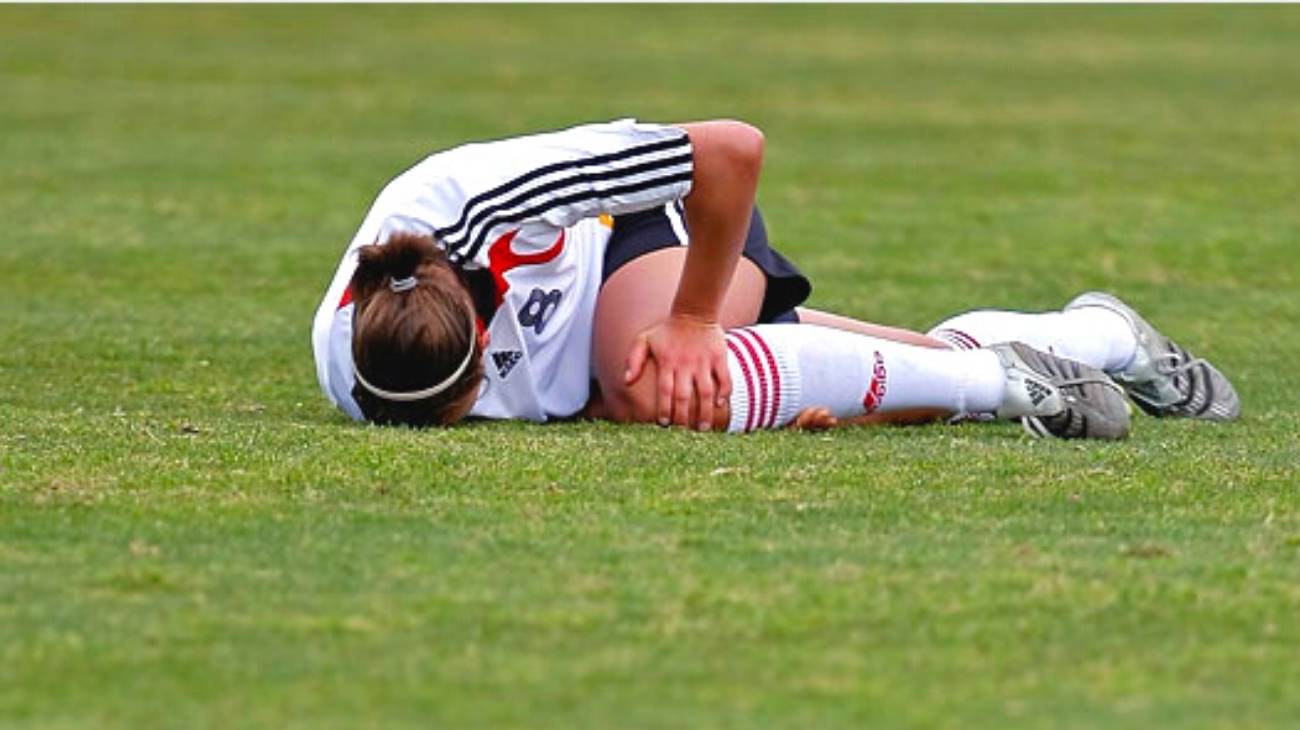From the days of Pele to Messi and Ronaldo, football has changed a lot in technique, intensity and the frequency of sports injuries. In its latest report, FIFA indicates that most injuries are generated by contact between players in training.
We will give an overview of the most common injuries, ailments and discomforts in football, how to prevent injuries in this sport and how to apply the PRICE therapy as first aid techniques. This is a useful guide that you as a professional should know.
What are the most common types of injuries when playing football?
Intercepting the ball, running with it from midfield and preventing the opponent from taking it away from you are constant scenarios in 90 minutes of regulation play, and it is likely that in that time you will collide with them and sustain an injury.
Or maybe you were already recovered from a sprain and the intensity of the competition triggered the ailment again. Whatever the case, football injuries are not life-threatening, but they are career-threatening, which is why you should know this list of the most common football injuries.
Hip injuries
The hip is a key part of a football players body because it is used for dribbling (dribbling is done with the legs but the deception is centred on the hip), so those who play in attacking or wing positions use it a lot.
- Pubalgia: When this injury occurs, there is severe pain in the groin area and lower abdomen. It occurs in football players due to an overload of energy in the hip muscles. The pain is mild at first, but becomes chronic as the days go by without proper treatment and physiotherapy.
- Hip bursitis: This is inflammation of a cushioning bursa in the hip joints. It can be trochanter bursitis or trochanteritis. The bursa becomes overfilled with fluid (bursa) and requires drainage to reduce the swelling and pain felt throughout the hip. It is caused by a heavy blow to the hip in the case of football players or by the accumulation of wear and tear on the joint after several matches.
Leg injuries
The legs take the most knocks and this is the most injured part of the body of any football player in the world. Some of the most common injuries are:
- Tearing of muscle fibres: The tearing or pulling of any muscle occurs when the muscle is stretched to extremes as a result of intense matches in which the muscles reach their limit. Although muscles are resilient, they break when the force exerted on them exceeds their endurance capacity.
- Thigh contracture: This occurs when the force on the muscle fibres far exceeds their capacity for resistance. The work of the muscles is to shorten and stretch, but sometimes the tissues do not stretch again. If the contraction is mild, just wait a few minutes and try to stand up so that the muscle stretches again and then relaxes. It usually happens when the muscle is subjected to extreme stress such as in a match that goes into overtime.
Knee injuries
They say that the difference between the talented and the geniuses is in the knees, and it is this joint that can be the biggest handicap to a promising young player's career if it is not properly strengthened.
- Cruciate ligament rupture: A sudden strong stretch causes this structure to swell and cause pain. What to look out for? Clicking (when torn), difficulty moving the knee, instability when standing and severe pain. It is also caused by aggressive rotation of the knee or by a very violent tackle by an opponent where the full weight of the body falls on the knee and causes a very pronounced twist.
- Meniscal tear: A meniscal tear is a process of wear and tear that results in pain, swelling and the inability to continue playing football for a long period of time. Each knee has two menisci which cushion the movement of the athlete. When the knee is twisted forcefully as a result of an opponent's tackle or an unfortunate fall, the menisci become inflamed and no longer provide stability when walking, jogging or running.
Calf injuries
While rarely a severe problem, many injuries to this part of the body can keep players out of competition for weeks at a time:
- Achilles tendinopathy: This is a typical injury among football players due to the strain on the so-called Achilles tendon. Almost all cases of tendinopathy are solved with rest and medication, but when injected treatments do not work, minor surgery should be performed.
- Calf injury: A calf muscle injury can occur either from an opponent's tackle, or from an accidental tear from straining the muscle tissue too much in matches where we push our bodies to the extreme. Immediately you feel a loss of strength in the calf and the ability to walk becomes difficult.
Ankle injuries
The ankles are as essential as the knees as an ankle injury can limit both the power of the kick and the power of the shot.
- Sprained ankle: Another of the most common injuries, on average 30% of all soft tissue injuries in football occur in the ankle. Remember that this joint receives all the load of the body weight in the stops, starts and change of direction, it is also the part that receives more kicks and blows, so it is very common that a sprain occurs that damages the ligaments of the same.
- Lateral ligament injuries: Three ligaments function on the outer sides of each ankle and help maintain balance and stability. Any one of them, even all three at once, can become inflamed from overuse. You'll feel the pain right away. The anterior peroneal astragal ligament is the one that suffers the most and when the force exceeds its capacity, tears occur that must be treated with physiotherapy if they are partial or surgery if they are total.
Foot injuries
Foot injuries are rare compared to other parts of the body, but among the most common injuries are some that can keep you out of competition for weeks, such as the following:
- Fracture of the fifth metatarsal: This metatarsal is the most commonly injured and can be caused by the opponent stepping on the little toe, or by stress, which usually occurs if we wear shoes that are smaller than our foot requires.
- Plantar fasciitis: Do you have heel pain? This is likely to be an inflammation of the plantar fascia, a tissue that runs along the sole of the foot and is easily injured by the wear and tear of running, jumping, braking and walking. This tissue also connects the toes, so the pain will go from the heel to the tip of the toes. Only with an X-ray can you be sure of this ailment and thus start a good treatment.
Best products for football injury recovery
Bestseller
-
2 Ankle Compression Sleeve (Black/Gray)
£20,95 -
2 Ankle Compression Sleeve (Green/Navy)
£20,95 -
2 Ankle Compression Sleeve (Pink/Bordeaux)
£20,95 -
2 Calf Compression Sleeve (Black/Gray)
£20,95 -
2 Calf Compression Sleeve (Green/Navy)
£20,95 -
2 Calf Compression Sleeve (Pink/Bordeaux)
£20,95 -
2 Knee Compression Sleeve (Black/Gray)
£20,95 -
2 Knee Compression Sleeve (Green/Navy)
£20,95 -
2 Knee Compression Sleeve (Pink/Bordeaux)
£20,95 -
2 Thigh Compression Sleeve (Black/Gray)
£20,95 -
2 Thigh Compression Sleeve (Green/Navy)
£20,95 -
2 Thigh Compression Sleeve (Pink/Bordeaux)
£20,95 -
Ice Pack for Foot - Cold Therapy Socks (Black)
£20,95 -
Ice Pack for Foot - Cold Therapy Socks (Green)
£20,95 -
Ice Pack for Foot - Cold Therapy Socks (Pink)
£20,95 -
Microwavable Heated Slippers (Hearts)
£24,95 -
Microwavable Heated Slippers (Oxford)
£24,95 -
Microwavable Heated Slippers (Sport)
£24,95
-
2 Patella Knee Strap (Black/Gray)
£12,95 -
2 Patella Knee Strap (Green/Navy)
£12,95 -
2 Patella Knee Strap (Pink/Bordeaux)
£12,95 -
Foot Massage Roller for Plantar Fasciitis (Black)
£20,95 -
Foot Massage Roller for Plantar Fasciitis (Green)
£20,95 -
Foot Massage Roller for Plantar Fasciitis (Pink)
£20,95 -
Ice Massage Roller Ball (Black)
£34,95 -
Ice Massage Roller Ball (Green)
£34,95 -
Ice Massage Roller Ball (Pink)
£34,95 -
Sacroiliac Support Belt (Black)
£24,95 -
Sacroiliac Support Belt (Green)
£24,95 -
Sacroiliac Support Belt (Pink)
£24,95 -
Soft Density Foam Roller for Recovery (Black)
£34,95 -
Soft Density Foam Roller for Recovery (Green)
£34,95 -
Soft Density Foam Roller for Recovery (Pink)
£34,95 -
Sport Compression Socks (1 Pair) (Black/Gray)
£20,95 -
Sport Compression Socks (1 Pair) (Green/Navy)
£20,95 -
Sport Compression Socks (1 Pair) (Pink/Bordeaux)
£20,95
How to prevent injuries when playing football?
No player wants to be injured, let alone miss an entire season because of a fracture, so we show you what you should do to avoid an injury that could lead to you being out of the game.
- Warm up well: All training should start with general and specific warm-ups. It is just as important as the training itself because it adjusts the metabolic function to the sporting activity. A good warm-up increases heart rate and lung capacity, both vital qualities in football athletes who have to jog and run for 90 minutes. Warming up also prepares the player's mind to match his physical performance.
- Finish training with a cool-down: This phase is intended to bring the body back to its natural state, before starting the warm-up. It only takes about 20 minutes or less, depending on the athletic condition of the player and how accustomed he is to intense training. Why cool down after training? To normalise body functions such as blood circulation and general blood pressure.
- Good nutrition and hydration. The most important part of nutrition should be during training. Before arriving at a match, there should be enough carbohydrates in the body to withstand the intensity of football. The day before the game, dinner should be two hours before bedtime and should not be heavy: pasta, rice and vegetable salads are good choices. On the other hand, good hydration regulates body temperature.
- Improve your fitness: Any exercise that helps to improve your endurance and strength will be good for you, as long as you avoid developing too much muscle mass that makes you heavy and slow. Remember that football is a sport of agility and speed. The best fitness will be achieved in your team's own training sessions. Although you are free to do other practices, taking into account that you do not have injuries or unnecessary wear and tear.
- Sports massage: With a good massage the ability to continue training is restored better and faster. It also strengthens the soft tissues and helps to prevent injuries. A relaxing massage is not the same as a sports massage, with the latter we achieve specific objectives such as the release of tension (discomfort) accumulated in a single area of the body. When should we not apply sports massage? In cases of fractures or sprains.
- Use of cold and heat therapies: Each one has specific functions in the organism, although for the immediate treatment of injuries, cold is applied due to its anti-inflammatory effect. Cold reduces joint stiffness, swelling and bruising in case of severe blows to the skin. Muscle spasms are also treated with cold. Heat reduces chronic pain in joints and soft tissues, but only a physiotherapist can use heat on an athlete.
- Use of compression garments: Their use is no longer limited to muscle recovery due to fatigue. Today, the garments allow better performance, control body temperature and promote circulation. More than a fad, the use of compression socks in football is a necessity because it improves blood return and prevents a muscle from swelling when it is strained to the extreme.
- Use of acupressure therapies: Chinese medicine has given the sporting world an excellent alternative therapy for the treatment of muscle tension. It involves pressure on certain points in the body using the fingers and palms of the hands, unlike acupuncture which uses needles. By using the hands on these points, blood flow is controlled and tension nested in joints, tendons and ligaments is released.
- Use of thermotherapy and cryotherapy: Both therapies have proven long-term benefits for the treatment of chronic injuries. It is more than just placing hot or cold packs, this is another level of therapeutic approach. Cryotherapy has been used since the 1970s, using temperatures below -130°C, making this technique dangerous in inexperienced hands, such as those of the football player himself. Thermotherapy results in a better physiological response, a better circulatory and lymphatic response, and an increase in collagen flexibility.
- Use of good equipment: The shirt should be made of breathable fabric that helps to control the flow of sweat in the body and should not represent a dead weight or discomfort for the players. Shorts must also have this synthetic fabric. Players may only wear compression shorts if they are short and do not exceed the length of the uniform. It is recommended that socks are made of cotton, so there is less friction between the player's skin and the inside of the footwear.
How to apply the RICE therapy to treat first aid injuries in football players?
This method is very easy to use, it should only be taken into account that it is efficient in case of minor injuries and soft tissue injuries. It should not be used when fractures are known to be present. PRICE is an update of the RICE therapy, which appeared in the 1970s and is better known in the sporting world.
- Protection: The first thing to do is to protect and isolate the injured area to prevent movement that could aggravate the injury. You can use a classic bandage to cover the injury.
- Rest: All injuries require time without movement in order to recover. Tissues regenerate after an injury, but we must contribute by not moving the affected limb.
- Ice: You already know how to use ice, now we explain that there should be a 10-minute rest for every 20 minutes of using cold on the injury. You should never place ice directly on the skin, as there will be redness due to burning.
- Compression: It is more effective if the football player already has knee and ankle pads, which are the joints most affected by injuries. If these elements are not available, you can use an elastic bandage and exert moderate pressure on the injury.
- Elevation: You want to reduce blood pressure. In addition, combined with ice and compression, it reduces pain, reduces swelling and prevents oedema from spreading
References
- Inklaar, H. (1994). Soccer injuries: I: incidence and severity. Sports medicine, 18, 55-73. https://link.springer.com/article/10.2165/00007256-199418010-00006
- Inklaar, H. (1994). Soccer Injuries: II: Aetiology and Prevention. Sports medicine, 18, 81-93. https://link.springer.com/article/10.2165/00007256-199418020-00002
- Ekstrand, J., & Gillquist, J. (1983). Soccer injuries and their mechanisms: a prospective study. Medicine and science in sports and exercise, 15(3), 267-270. https://europepmc.org/article/med/6621313
- Dvorak, J., & Junge, A. (2000). Football injuries and physical symptoms. The American journal of sports medicine, 28(5_suppl), 3-9. https://pubmed.ncbi.nlm.nih.gov/11032101/
- Faude, O., Rößler, R., & Junge, A. (2013). Football injuries in children and adolescent players: are there clues for prevention?. Sports medicine, 43, 819-837. https://link.springer.com/article/10.1007/s40279-013-0061-x
- Arnason, A., Sigurdsson, S. B., Gudmundsson, A., Holme, I., Engebretsen, L., & Bahr, R. (2004). Risk factors for injuries in football. The American journal of sports medicine, 32(1_suppl), 5-16. https://journals.sagepub.com/doi/abs/10.1177/0363546503258912
- Östenberg, A., & Roos, H. (2000). Injury risk factors in female European football. A prospective study of 123 players during one season. Scandinavian journal of medicine & science in sports, 10(5), 279-285. https://onlinelibrary.wiley.com/doi/abs/10.1034/j.1600-0838.2000.010005279.x
- Ekstrand, J., Hägglund, M., & Waldén, M. (2011). Epidemiology of muscle injuries in professional football (soccer). The American journal of sports medicine, 39(6), 1226-1232. https://journals.sagepub.com/doi/abs/10.1177/0363546510395879
- Hallén, A., & Ekstrand, J. (2014). Return to play following muscle injuries in professional footballers. Journal of sports sciences, 32(13), 1229-1236. https://www.tandfonline.com/doi/abs/10.1080/02640414.2014.905695
- Hespel, P., Maughan, R. J., & Greenhaff, P. L. (2006). Dietary supplements for football. Journal of Sports Sciences, 24(07), 749-761. https://www.tandfonline.com/doi/abs/10.1080/02640410500482974































